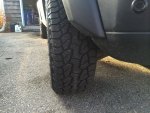This is a misleading statement and simply untrue for how most people would use the vehicle IF they are fitting anything other than the stock tires. While during normal street driving there may be "minor rubbing", any compression of the rear wheels up into the arch will cause dramatic rubbing and damage to the fender liner and parts beneath it. Even using the "access" mode would rub significantly. The modification for this tight area would not be considered "minimal" by most people unless they have their own shop and experience with such things.
I suppose everybody has a different opinion of what 'minor rubbing' and 'minimal trimming' means; therein lies the 'rub' with the web.
The inner fender liner would indeed be damaged if you did no trimming. However, the 'damage' would simply be that it would wear a hole in the area at the forward edge of the wheel well. That's hardly significant. The worst thing about that would be listening to the noise when it does rub. Once it wears through the plastic it could contact the metal body seam under the liner. However, it would only contact that under heavy articulation, not cruising down the highway, so it would be minimal. The tire obviously won't hurt the metal seam, though it *might* eventually grove the tire tread a bit after extensive use.
If you have the HSE with the rear AirCon, then you may also contact the aluminum coolant tubes that run next to the body seam after wearing through the plastic. Again, being metal, occasional contact would take a very long time to cause any actual damage.
As noted, on mine I simply removed the plastic fender liner and re-routed the a/c lines then trimmed down the body seam and re-installed the plastic. Then used a heat gun to soften the plastic and push it out of the way a bit. Hasn't rubbed since. Oh, and I had it in access mode just today
I can understand that some people might not want to take this on themselves if they are not comfortable with a spanner. But that doesn't mean it's not a simple/minor mod.
Also, as noted in my prior posts, I trimmed about 1/8 to 1/4" of plastic from areas of the front wheel wells to avoid rubbing at full lock, mostly when backing. Obviously you would only get that under very limited circumstances, but as it was such an easy thing to do you might as well do it while you've got the tool box open.

